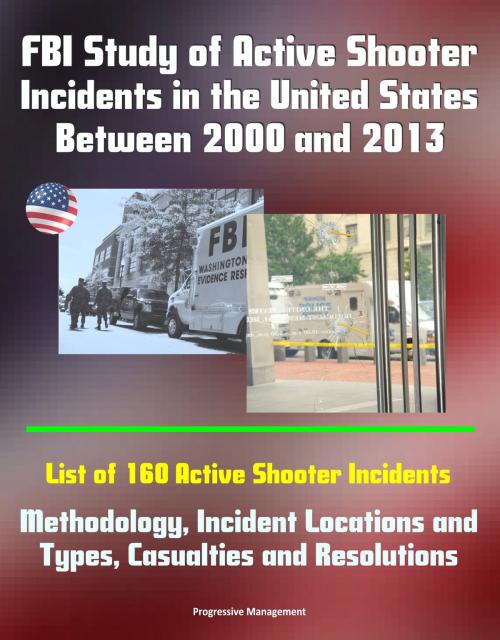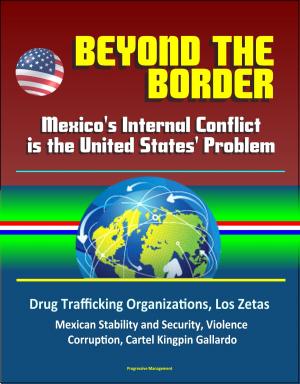FBI Study of Active Shooter Incidents in the United States Between 2000 and 2013: List of 160 Active Shooter Incidents, Methodology, Incident Locations and Types, Casualties and Resolutions
Nonfiction, Social & Cultural Studies, Social Science, Crimes & Criminals, Murder, True Crime| Author: | Progressive Management | ISBN: | 9781310409806 |
| Publisher: | Progressive Management | Publication: | October 6, 2014 |
| Imprint: | Smashwords Edition | Language: | English |
| Author: | Progressive Management |
| ISBN: | 9781310409806 |
| Publisher: | Progressive Management |
| Publication: | October 6, 2014 |
| Imprint: | Smashwords Edition |
| Language: | English |
In 2013, the president signed into law the Investigative Assistance for Violent Crimes Act of 2012, which granted the attorney general the authority to assist in the investigation of "violent acts and shootings occurring in a place of public use" and in the investigation of "mass killings and attempted mass killings at the request of an appropriate law enforcement official of a state or political subdivision."
To provide further clarity on these threats, the Federal Bureau of Investigation (FBI) in 2014 initiated a study of "active shooter" incidents. The goal of the FBI study is to provide federal, state, and local law enforcement with data so they can better understand how to prevent, prepare for, respond to, and recover from these incidents.
Active shooter is a term used by law enforcement to describe a situation in which a shooting is in progress and an aspect of the crime may affect the protocols used in responding to and reacting at the scene of the incident. Unlike a defined crime, such as a murder or mass killing, the active aspect inherently implies that both law enforcement personnel and citizens have the potential to affect the outcome of the event based upon their responses.
The agreed-upon definition of an active shooter by U.S. government agencies—including the White House, U.S. Department of Justice/FBI, U.S. Department of Education, and U.S. Department of Homeland Security/Federal Emergency Management Agency—is "an individual actively engaged in killing or attempting to kill people in a confined and populated area." Implicit in this definition is that the subject's criminal actions involve the use of firearms.
For purposes of its study, the FBI extended this definition to include individuals, because some incidents involved two or more shooters. Though the federal definition includes the word "confined," the FBI excluded this word in its study, as the term confined could omit incidents that occurred outside a building. Whether inside or out, these incidents still posed a threat to both law enforcement and the citizens they seek to protect.
A Study of Active Shooter Incidents in the United States between 2000 and 2013 * Introduction * Snapshot * Findings * Casualties * Resolutions * Law Enforcement/Security Personnel Casualties * Shooter Outcomes * Locations * Breakdown by location * Commercial Areas * Educational Environments * Open Spaces * Military and Other Government Properties * Residences * Houses of Worship * Health Care Facilities * Conclusion
In 2013, the president signed into law the Investigative Assistance for Violent Crimes Act of 2012, which granted the attorney general the authority to assist in the investigation of "violent acts and shootings occurring in a place of public use" and in the investigation of "mass killings and attempted mass killings at the request of an appropriate law enforcement official of a state or political subdivision."
To provide further clarity on these threats, the Federal Bureau of Investigation (FBI) in 2014 initiated a study of "active shooter" incidents. The goal of the FBI study is to provide federal, state, and local law enforcement with data so they can better understand how to prevent, prepare for, respond to, and recover from these incidents.
Active shooter is a term used by law enforcement to describe a situation in which a shooting is in progress and an aspect of the crime may affect the protocols used in responding to and reacting at the scene of the incident. Unlike a defined crime, such as a murder or mass killing, the active aspect inherently implies that both law enforcement personnel and citizens have the potential to affect the outcome of the event based upon their responses.
The agreed-upon definition of an active shooter by U.S. government agencies—including the White House, U.S. Department of Justice/FBI, U.S. Department of Education, and U.S. Department of Homeland Security/Federal Emergency Management Agency—is "an individual actively engaged in killing or attempting to kill people in a confined and populated area." Implicit in this definition is that the subject's criminal actions involve the use of firearms.
For purposes of its study, the FBI extended this definition to include individuals, because some incidents involved two or more shooters. Though the federal definition includes the word "confined," the FBI excluded this word in its study, as the term confined could omit incidents that occurred outside a building. Whether inside or out, these incidents still posed a threat to both law enforcement and the citizens they seek to protect.
A Study of Active Shooter Incidents in the United States between 2000 and 2013 * Introduction * Snapshot * Findings * Casualties * Resolutions * Law Enforcement/Security Personnel Casualties * Shooter Outcomes * Locations * Breakdown by location * Commercial Areas * Educational Environments * Open Spaces * Military and Other Government Properties * Residences * Houses of Worship * Health Care Facilities * Conclusion















